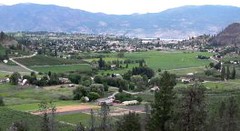Article 4 - Good Redevelopment, Poor Redevelopment
This article is intended to promote discussion prior to the Smart Growth workshop.
Redevelopment is a great way to revitalise and to create jobs and ongoing wealth without population growth. That is why, despite having relatively small population growth over the past 100 years or more, many small European towns are pleasant and prosperous places to live.
One of the best redevelopments Summerland has seen over the past 25 years was the Downtown Revitalisation project. Cracked sidewalks, a delapidated air, few shoppers and numerous unoccupied storefronts on Main Street were a sign that something had to be done! I one day counted 10 unoccupied storefronts on Main Street alone. It is easy to forget, but there were so few shoppers that, even at busiest times, there was always lots of parking available (even though the parallel parking of those days provided half as many spaces as today's angled parking does).
The downtown merchants had the courage and foresight to put up with months of disruption for better future prospects. Nowadays the downtown is an attractive place to be. Whilst there is still much that could and should be done to further support the downtown, the revitalisation project was a great success when the strictest test is applied, i.e gains v losses. Summerland gained a great deal, permanently, and lost nothing except some short term discomfort and temporary business stress.
For an example of a poor redevelopment, consider the replacement of McDonald school by the new middle school. The new building is functional and no doubt more healthy and comfortable than the old one. Having said that, the project managed to get almost everything else wrong plus it created problems where non existed before. Here's the sad score card.
Redevelopment is a great way to revitalise and to create jobs and ongoing wealth without population growth. That is why, despite having relatively small population growth over the past 100 years or more, many small European towns are pleasant and prosperous places to live.
One of the best redevelopments Summerland has seen over the past 25 years was the Downtown Revitalisation project. Cracked sidewalks, a delapidated air, few shoppers and numerous unoccupied storefronts on Main Street were a sign that something had to be done! I one day counted 10 unoccupied storefronts on Main Street alone. It is easy to forget, but there were so few shoppers that, even at busiest times, there was always lots of parking available (even though the parallel parking of those days provided half as many spaces as today's angled parking does).
The downtown merchants had the courage and foresight to put up with months of disruption for better future prospects. Nowadays the downtown is an attractive place to be. Whilst there is still much that could and should be done to further support the downtown, the revitalisation project was a great success when the strictest test is applied, i.e gains v losses. Summerland gained a great deal, permanently, and lost nothing except some short term discomfort and temporary business stress.
For an example of a poor redevelopment, consider the replacement of McDonald school by the new middle school. The new building is functional and no doubt more healthy and comfortable than the old one. Having said that, the project managed to get almost everything else wrong plus it created problems where non existed before. Here's the sad score card.
- Historic building of character, with design sympathetic to the downtown theme, replaced by a cookie cutter building designed with one thing in mind - lowest cost.
- Jubilee road between the Dunham fields used to have a tight 90 degree bend that automatically kept traffic slow in the school zone. The sweeping curve in the new road alignment encourages higher speeds.
- A staggered junction that worked well was replaced by a cross roads that immediately became a difficult junction to use.
- The Dunham fields had a parklike feel, and they were enjoyed by all sorts of casual users. You could pull your car off the road and enjoy a walk, or play with your children for a few minutes. Today's flat, feaureless fields with their ugly chain links fences are unattractive and get little casual use. Phsychologically Summerland lost a downtown park when the Dunham fields disappeared.
- The lower (northern) Dunham field, with its shade trees and grassy bank alongside the road, made a natural tiered seating area for spectators watching sports events.


1 Comments:
Hi Tony;
I tried to post a comment on the blog site re: Smart Growth workshop but couldn't figure out how to do it. Just call me techno incompetent. If possible I would like to see some discussion around industry and what proportion of a community should be provided for industry or does anyone even know the answer to that question. Industrial lands are becoming increasingly scarce, in the Okanagan and the lower mainland as well as across Canada. A lot of people think it's better to not have industry but that's a bit like letting everyone else vaccinate their kids so you don't have to worry about vaccinating your own. I think a healthy community is an economically healthy community and that usually means economic diversity and I don't think that issue gets much serious consideration from a lot of people.
Thanks,
Barrie Karner
P.S. If you can figure out how to put my comments on the blog site feel free to do so.
By tony cooke, at 10:27 a.m.
tony cooke, at 10:27 a.m.
Post a Comment
<< Home